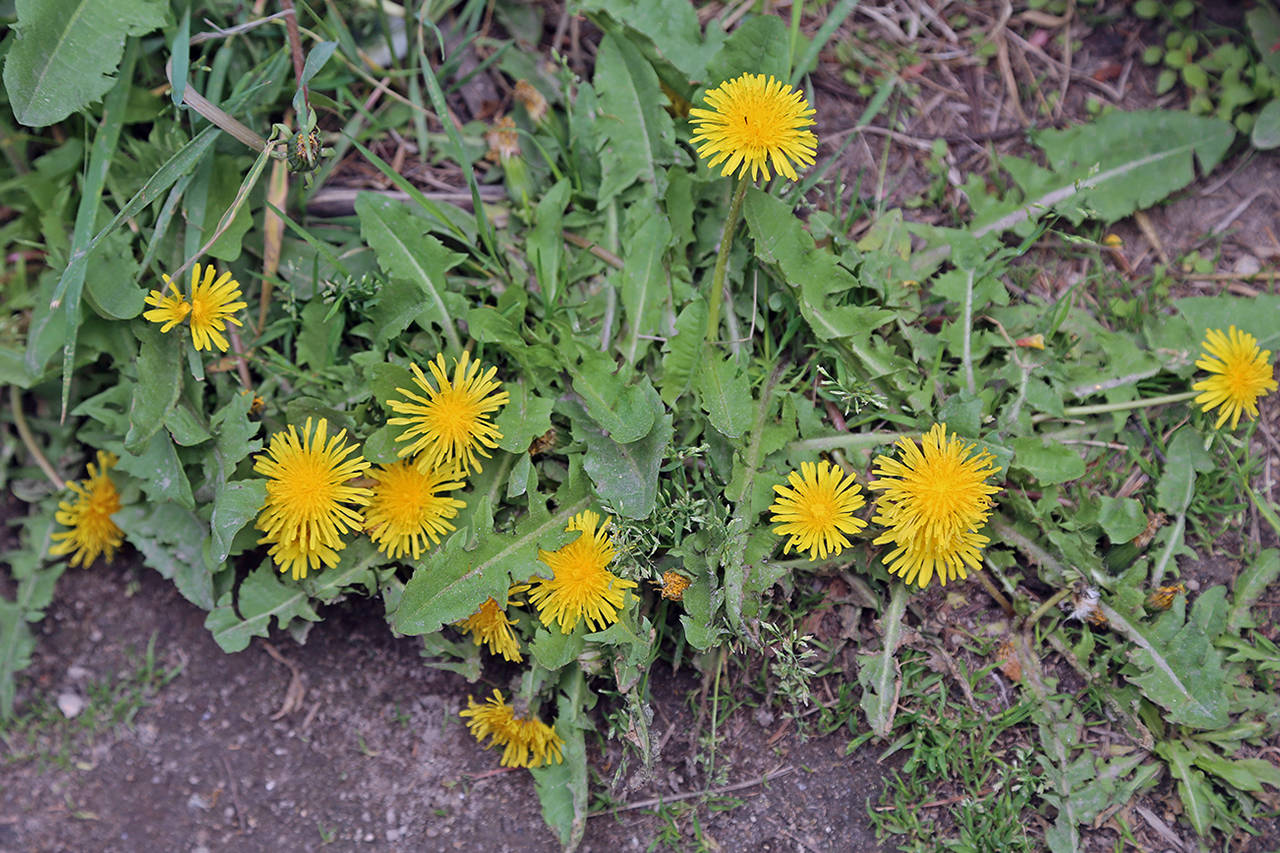By Dauna Koval
WSU Master Gardener
You will find a lot of yellow-flowered weeds everywhere — in waste areas, flower and vegetable gardens, and most conspicuously in lawns. Although we are used to calling them all dandelions, they are a group or tribe of different plants in the sunflower (Asteraceae) family.
Why do we care? Each species has different growth habits and requires different methods of eradication. Most varieties are aggressive, invasive plants that will overwhelm more fragile natives and disrupt a green carpet lawn. On the positive side, they are all great pollinator plants that bring beneficial bees and butterflies to your garden.
As members of the same tribe, all of these plants have hollow stems that contain a milky-white, latex-based fluid when broken. This can irritate the skin of some people, especially those allergic to the flowers.
As their flowers mature, each species produces a delicate white ball called a pappus that, when blown apart, disburses the seeds — each with its own “parachute.” (Grandmas, don’t teach your grandchildren how much fun these are to blow apart!)
• The True or Common Dandelion (Taraxacum officinale) is a perennial that lives up to 10 years and flowers nearly nine months of the year. Its long, sometimes branching taproot reaches down several feet into the ground, where it can break up heavy clay soils.
An adaptable plant, it varies in height, stretching to reach the sunlight or producing flowers on shorter stalks if continually mowed. Its smooth, light, papery leaves form basal rosettes slightly or deeply toothed (like lions’ teeth.) Rosettes produce one or two stems, each of which sports a single 2-inch yellow composite flower.
You can try eradicating it by cutting or mowing the entire plant, making sure to get the leaves; but this will take several years of repeated mowing for success. A better but more difficult way is to dig out each plant, before the flowers mature. Remove the entire taproot, since any piece left will produce another plant.
• The Hairy Cat’s Ear (Hypochaeris radicata) is the tribe member found in sandy soils. If you live in Ocean Shores, this is the weed you see the most.
Like the True Dandelion, it is a perennial with basal leaves, but the leaves are heavier and only slightly toothed. They have dense hair on both sides. Reach down and touch them: You will know instantly which plant is which, and how this one got its name.
Its multiple taproots are shorter and lighter colored than True Dandelions and are much easier to pull. The basal rosettes grow flat and smother whatever is trying to grow underneath. If you want a lawn, you will need to get rid of them. Mowing doesn’t do any good; it simply cuts off the flowers, which return in a day or two. The flattened basal rosette escapes mowing altogether. You will need to pull each plant, a task much easier than digging out True Dandelions.
• In the shade, often under decks, grow Prickly Sow-Thistles (Sonchus apser,) another of the dandelion tribe — not a true thistle. These are annuals, with softly prickled, tooth-edged leaves that alternate up the entire, longer stalk.
The ¾- to 1-inch yellow flowers are smaller and have fewer petals than either of the above. Several flower heads cluster on each stem.
Mowing them before the flowers mature produces some success, but a better way is to till or pull them. Taproots are short and usually do not readily grow back.
• Hawkweed (Hieracium umbellatum) is a tall (2 to 4 feet) perennial that prefers moister, shadier areas than the three above.
Stems branch only at the tips and product a flat-topped cluster of heads that open into smaller, fewer-petaled flowers. Leaves are narrow, usually toothed, and they diminish in size the further up the stalk.
Hawkweed has fibrous roots that are relatively easy to pull, which is the best way to eradicate them.
* * *
Do you have a problem with a plant, or do you want some help with disease prevention in your garden? Do you need help finding the best plant for a location? Ask a WSU Master Gardener! Go to PNWMG.org and post your question where you see “Ask a Master Gardener” toward the bottom of the home page.
Dauna Koval, a Master Gardener since 2016, left her King County garden of 15 years to retire to Ocean Shores. The dandelion tribe followed her.



